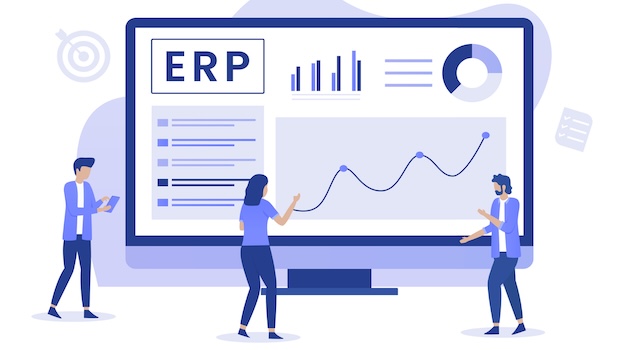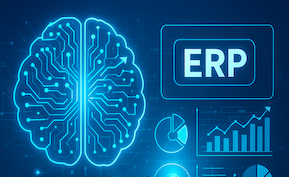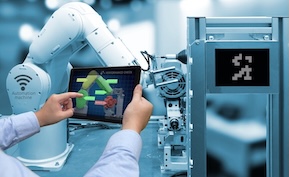Introduction: Manufacturers today face a volatile mix of market fluctuations, supply chain disruptions, labor shortages, and sustainability pressures. Traditional ERP systems provide robust transaction management and reporting, but they often fall short in scenario planning and risk modeling. Enter digital twins and simulation technologies—virtual replicas of physical assets, processes, or systems. When integrated with ERP, these tools transform decision-making by enabling “what-if” analysis, predictive modeling, and real-time optimization. This article explores how digital twins and simulation extend the value of ERP for manufacturers and help future-proof operations against uncertainty.
What is a Digital Twin?
A digital twin is a virtual model of a real-world process, product, or system that mirrors its behavior using real-time and historical data. In manufacturing, digital twins may represent a factory line, a warehouse, a machine, or even the entire supply chain. Paired with IoT sensors and ERP data, the digital twin continuously updates to reflect actual performance. This creates a testbed for experimenting with process improvements or stress-testing systems without risking downtime in the real environment.
Why Digital Twins Matter for ERP
ERP systems manage core data such as bills of materials, work orders, and inventory levels. Digital twins amplify ERP’s value by:
- Providing Contextual Simulation: ERP tells you what’s happening; a digital twin shows how it might evolve.
- Predicting Outcomes: By feeding ERP data into a digital twin, manufacturers can forecast equipment failure, demand spikes, or supply delays.
- Reducing Risk: Companies can test changes virtually—new production schedules, supplier substitutions, or equipment upgrades—before applying them in reality.
This predictive and experimental capability turns ERP from a reactive reporting tool into a proactive decision engine.
Applications of Digital Twin-Enhanced ERP in Manufacturing
Manufacturers are applying digital twin and simulation tools within ERP across a range of use cases:
- Production Planning: Simulating shop-floor processes to test different production schedules, capacity adjustments, and resource allocations.
- Maintenance Scheduling: Linking equipment twins with ERP maintenance modules to anticipate failures and plan interventions during low-demand periods.
- Supply Chain Modeling: Using twins of warehouses, logistics routes, and suppliers to assess how disruptions ripple across the network.
- Product Lifecycle Management: Modeling new product designs for manufacturability, cost, and sustainability within ERP-controlled environments.
- Energy & Sustainability Optimization: Testing facility energy usage scenarios to minimize carbon footprint while meeting production targets.
Each application extends ERP’s core functions by adding a layer of foresight and experimentation.
Simulation and “What-If” Scenarios
One of the greatest strengths of digital twins is the ability to run “what-if” scenarios. Manufacturers can ask questions like:
- What if a key supplier shuts down for two weeks?
- What if demand spikes by 30% in Q4?
- What if we switch to a more energy-efficient machine line?
- What if a new regulatory compliance rule increases production costs?
ERP-integrated simulations allow planners to test these situations and model financial, operational, and customer service impacts—without touching the real shop floor. This supports agile and informed decision-making.
Risk Mitigation Through ERP-Digital Twin Integration
Risk management is becoming a boardroom priority, and ERP with digital twins offers powerful mitigation capabilities:
- Disruption Recovery Planning: Simulate facility shutdowns or supplier issues to design rapid recovery playbooks.
- Compliance & Regulation Modeling: Test the cost and process impact of new compliance requirements before enforcement dates.
- Labor Force Scenarios: Model workforce shortages and overtime costs, aligning HR planning with ERP workforce modules.
- Cybersecurity & IT Risks: Run digital risk scenarios for ERP downtime or data breaches, preparing response strategies.
These proactive measures reduce financial exposure and build organizational resilience.
Technical Considerations for ERP and Digital Twin Integration
Manufacturers should plan carefully for integration, focusing on:
- Data Synchronization: ERP must feed the digital twin continuously to keep simulations accurate.
- IoT Infrastructure: Sensors on machines, conveyors, and storage systems provide the raw data for twins.
- Cloud Platforms: Cloud-based ERP simplifies scaling and computational demands for simulations.
- Visualization Tools: 3D modeling software or dashboards make simulation outcomes accessible to decision-makers.
- Interoperability: Ensure twin platforms integrate seamlessly with existing ERP modules and analytics tools.
Strong technical foundations ensure simulations deliver actionable insights instead of overwhelming complexity.
Best Practices for Implementation
To maximize ROI from digital twin-enhanced ERP, manufacturers should follow best practices:
- Start with High-Value Assets: Begin by creating digital twins of critical machines or production lines where downtime is costly.
- Align with Business Objectives: Tie twin initiatives to KPIs such as OEE (Overall Equipment Effectiveness), energy savings, or reduced lead time.
- Foster Cross-Functional Collaboration: Engage operations, engineering, IT, and finance teams to avoid siloed use of twin insights.
- Train for Scenario Planning: Provide staff with simulation training to interpret results and make agile decisions.
- Scale Iteratively: Expand from machine twins to full plant and supply chain simulations once early pilots prove valuable.
This structured rollout minimizes risk while delivering measurable improvements.
Future Outlook: Where ERP and Digital Twins Are Headed
Looking ahead, the ERP-digital twin partnership will evolve with emerging technologies:
- AI-Driven Autonomous Optimization: ERP systems will use AI to adjust schedules or workflows automatically based on simulation insights.
- Edge-Enabled Twins: Real-time shop-floor simulations running on edge devices will feed ERP without cloud latency.
- Extended Reality (XR): Managers may use augmented or virtual reality to interact with ERP-driven digital twins visually.
- Industry-Wide Twin Networks: Supply chain partners may connect digital twins for collaborative risk modeling across industries.
The convergence of ERP, IoT, and digital twin technologies points toward a future of predictive, agile, and highly efficient manufacturing operations.
Conclusion
ERP systems have long been the backbone of manufacturing data management, but the future belongs to platforms that go beyond reporting to forecasting and simulation. Digital twins empower manufacturers to run “what-if” scenarios, model risks, and optimize performance virtually before implementing changes in the real world. When paired with ERP, these tools create a dynamic ecosystem for proactive planning, efficient resource use, and resilient operations. Manufacturers that embrace ERP-digital twin integration today will gain a decisive edge in navigating tomorrow’s uncertainties.







